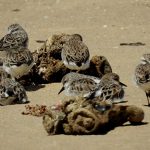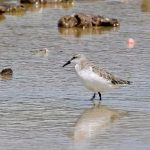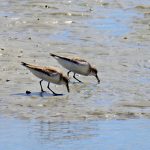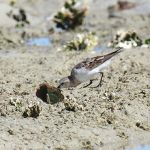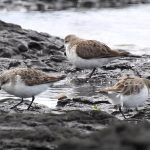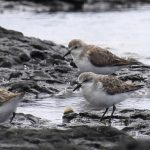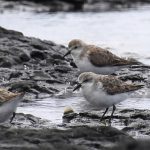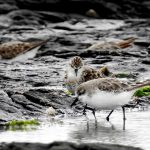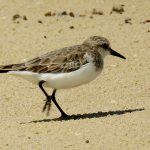RED-NECKED STINT
The Red-necked Stint is a bird of two worlds. During the Australian summer (which is the northern winter), these birds can be found across coastal Australia, favouring mudflats, estuaries, and sometimes inland wetlands, where they rest and refuel. Their presence in Australia is part of a migratory pattern that sees them travelling thousands of kilometres from their breeding grounds in the Arctic tundra of Siberia and Alaska. The Red-necked Stint’s migratory journey is one of the animal kingdom’s most awe-inspiring feats, covering up to 25,000 kilometres annually.
When it comes to dining, Red-necked Stints are methodical foragers. Their diet primarily consists of small invertebrates, which they skillfully pluck from mudflats and shallow waters. With delicate, rapid movements, they probe and pick at the mud’s surface, capturing everything from insects and crustaceans to molluscs. This diet is rich in the nutrients necessary for sustaining their long migratory flights and ensuring they are in good condition for breeding.
The breeding season beckons the Red-necked Stint back to the Arctic tundra, where the landscape transforms with the brief Arctic summer. Here, in a stark contrast to the Australian shores, they engage in a flurry of activity to continue their lineage. Nests are simple depressions on the ground, lined with leaves and lichen, where females lay a clutch of usually four eggs. Both parents share the duty of incubating the eggs, and once hatched, the chicks are precocial, ready to leave the nest within hours, guided by their parents to forage for food. These birds undergo a remarkable transformation in their plumage, from the subtle greys and whites of their non-breeding attire to the striking rufous neck and breast feathers that give them their name during the breeding season.
The life of a Red-necked Stint is one of constant movement and survival. On average, these birds can live for around 8 years, a remarkable feat considering the perils they face on their migratory journeys, including predators, habitat loss, and changing climates. Their longevity is a testament to their resilience and adaptability in the face of these challenges.

